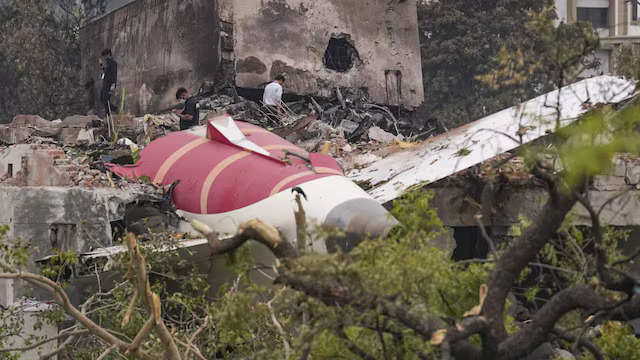As the investigation into Air India plane crash continues, Minister of State for Civil Aviation Murlidhar Mohol confirmed that sabotage is among the key angles being investigated in the Air India AI 171 crash that killed 274 people. Speaking at a recent conclave organised by NDTV, the minister said a comprehensive investigation is underway, with black box data and CCTV footage under scrutiny.
This comes just weeks after the aircraft, a Dreamliner bound for London, crashed in Ahmedabad shortly after takeoff, raising alarms within Indian intelligence. The rare dual engine failure has triggered a detailed probe to determine whether this was mechanical failure or a deliberate act of sabotage.
Inside the Sabotage Probe
The Aircraft Accident Investigation Bureau (AAIB) is leading a multi-agency investigation into the crash, probing all possible causes. Minister Murlidhar Mohol confirmed that sabotage is not being ruled out. He emphasized the need for a thorough inquiry, stating, “The incident is being probed from all angles, including any possible sabotage. CCTV footage is being reviewed and technical teams are actively working to uncover the truth.”
Multiple agencies are now exploring seven key sabotage angles:
- Maintenance Sabotage – Dreamliners require complex maintenance. Agencies are examining whether any unauthorized changes or overlooked faults were involved. Technician logs and tool usage are being scrutinized.
- Cyber-Physical Manipulation – Given the aircraft’s reliance on digital systems, cybersecurity experts are auditing engine control units, flight management software, and ground maintenance systems to rule out hacking or malware.
- Foreign Hand or Proxy Actor – Considering geopolitical implications, agencies are probing whether a hostile foreign entity or proxy group had any role in orchestrating the crash as a symbolic or strategic act.
- ATC or Airfield Interference – Investigators are analyzing communications and radar data to rule out signal jamming, GPS spoofing, or compromised air traffic control instructions.
- Targeted Passenger or Cargo – Investigators are cross-checking passenger and cargo manifests for potential intelligence, political, or criminal threats that could have made the aircraft a target.
- Fuel Chain Tampering – Investigators are checking the fuel sourcing and storage systems for any signs of chemical adulteration or contamination. Ground staff and fuel suppliers at Ahmedabad airport are under the scanner
- Insider Threats & Security Breaches – Access logs, biometric trails, and surveillance footage are being reviewed to ensure no unauthorized personnel tampered with the aircraft prior to departure.
The Crash That Shook a Nation
On June 12, 2025, Air India flight AI 171, a Boeing 787-8 Dreamliner took off from Ahmedabad’s Sardar Vallabhbhai Patel International Airport bound for London Gatwick. Just moments into the flight, the aircraft reported a mayday call as both engines failed mid-air. The plane, carrying 242 passengers and crew, plunged into the residential quarters of BJ Medical College in Meghaninagar, triggering an inferno that consumed several buildings.
Also read: Boeing Under Fire Again After Air India 787-8 Crash in Ahmedabad
Only one person onboard survived. The crash also killed nine people on the ground. With a death toll of 274, this has become one of the worst aviation disasters in Indian history. What makes the incident more alarming is the uncommon nature of the failure both engines stopping simultaneously on a relatively new aircraft with experienced pilots.
Black Box Data Key to Truth
Both black boxes the Cockpit Voice Recorder (CVR) and Flight Data Recorder (FDR) were recovered within 72 hours of the crash. They are being decoded by AAIB experts in Delhi, under full government oversight.
The CVR is expected to reveal the pilot’s final conversations, which will be key in understanding how both engines failed so suddenly. The FDR will show technical data such as throttle settings, engine temperatures, altitude changes, and control inputs, all critical in establishing the sequence of events.
The government has confirmed that the black boxes will not be sent abroad for decoding, citing national security and transparency. Investigators expect to complete the analysis within three months.
Strengthening India’s Aviation Security
While the crash exposed vulnerabilities, it also prompted a swift response. Air India grounded and inspected its entire fleet of Boeing 787 Dreamliners. The Directorate General of Civil Aviation (DGCA) has since cleared all aircraft as safe after conducting emergency safety audits.
Minister Mohol reaffirmed that the fleet was well-maintained and the pilots were highly experienced, adding, “It is too early to say anything conclusively. But once the report comes, it will be known whether it was an engine issue, a fuel issue, or sabotage.”
The investigation is also being seen as a test case for India’s aviation security infrastructure. The multiple layers of scrutiny ranging from cybersecurity to airport access are being re-evaluated to prevent future incidents.
Seeking Closure and Accountability
As families of the victims await answers, the government has assured a transparent and full-spectrum investigation. The sheer rarity of a dual engine failure on a modern aircraft necessitates a deeper inquiry into all possible causes, including sabotage.
The final report, due in three months, will determine whether AI 171 was a tragic accident or a catastrophic act of deliberate sabotage. What is certain, however, is that the tragedy has exposed the need for greater resilience and preparedness in India’s civil aviation sector. The investigation into the AI 171 crash is not just about uncovering the past it’s about protecting the future of Indian skies.
